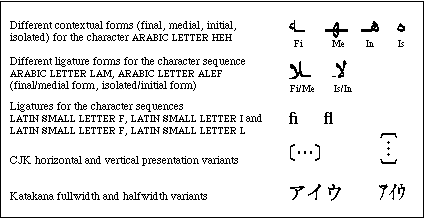Terminology
Many of the terms defined in this section are used informally. They are defined in order to facilitate the discussion in the remainder of this appendix.Character Sets and Encoding Schemes
A recent meeting on character sets organized by the Internet Architecture Board proposed a 7-layer architectural model for the transmission of text data. The first three layers are required for specifying the content of a transmitted text stream "on the wire"; higher layers specify language, locale, and so forth. As specified in the minutes of that meeting, the first three layers are
- coded character set (CCS), a mapping from a set of abstract characters to a set of integers. Examples include ISO 10646, ASCII, and the ISO 8859 series.
- character encoding scheme (CES), a mapping from one or more CCSs to a set of octets. Examples include ISO 2022 and UTF-8. A given CES is typically associated with a single CCS; for example, UTF-8 applies only to ISO 10646.
- transfer encoding syntax (TES), a transformation applied to character data encoded using a CCS and possibly a CES to allow it to be transmitted by a specific protocol or set of protocols. Examples include base64 and quoted-printable.
Other documents offer slightly different definitions of characteristics of a CCS, for example, a repertoire of abstract characters, range of numbers, and a mapping from numbers to characters (not necessarily invertible). Each of the integers in the set used to represent a CCS is called a code point.
- Note
- The term integer is used in this appendix in its mathematical sense; that is, it does not refer to the integer size on a particular CPU. Also, the term octet is used here instead of byte because the latter has not always meant an 8-bit unit; octet is explicitly defined to be an ordered sequence of 8 bits considered as a unit (the term is from ISO character set standards.

A CES might be more accurately described as a mapping from a sequence of elements in one or more CCSs to a sequence of octets. This definition suggests that the mapping from a single CCS element to its representation in the CES does not fully characterize the CES, which may include additional octets to set or change state information.
A TES is usually used to send 8-bit data through a transport mechanism that is only safe for 7-bit data, and even then may perform special handling for certain 7-bit values.
This appendix frequently uses the shorter term character set to mean coded character set and character encoding or encoding scheme to encompass both character sets and more complex character encoding schemes.
Characters, Glyphs, and Related Terms
Characters are the atomic units of content for text data; they include letters, digits, punctuation, and symbols. A character is an abstract entity without any particular appearance. A coded character is a character together with its numeric representation in a particular CCS.A text element is a group of one or more characters that is treated as a single entity for a particular process such as collation, display, or transcoding. The way that characters are grouped into text elements depends on the process; each process may group characters differently.
Glyph images are the visual elements used to represent characters; aspects of text presentation such as font and style apply to glyph images, not to characters. The mapping from a sequence of coded characters to a sequence of glyph images on a display device is complex. In general there is not a one-to-one mapping from character to glyph image; a particular glyph image may correspond to more or less than one character. Figure B-1 shows glyphs and their associated characters.
Figure B-1 Some glyph images for representing characters

A script is a collection of related characters, subsets of which are
required to write a particular language. Some examples of scripts are Latin, Greek, Hiragana, Katakana, and Han. A writing system consists of a set of characters from one or more scripts that are used to write a particular language and the rules that govern the presentation of those characters. Punctuation, digits, and symbols that are shared across many writing systems can be considered as one or more separate pseudo-scripts. For example, the Japanese writing system includes a Kanji subset of Han characters, plus Hiragana, Katakana, some Latin, and various punctuation and symbols, some of which are specific to CJK--Chinese, Japanese, Korean--or even just to Japanese, and some of which are more general.The term presentation form is generally used to mean a kind of abstract shape that represents a standard way to display a particular character or group of characters in a particular context as specified by a particular writing system. The term glyph by itself may refer either to presentation forms or to glyph images. This appendix assumes the latter convention. Figure B-2 shows some examples of presentation forms.

The determination of what is a character in a CCS should be based on what is
best for implementing the range of text processes for which that CCS will be used. The characters in a CCS need not correspond to what a user or linguist might consider a character. In fact, if the CCS will be used for more than one writing system, this might be impossible to do anyway, since each writing system has its own notion of what constitutes a natural character. Well-designed software should provide users with the behavior they expect or prefer, regardless of the details of the underlying character encoding, and without exposing users to those details.Some character sets that were intended primarily for display using less sophisticated display software have encoded presentation forms as characters. For example, the DOS Arabic character set (code page 864) encodes Arabic contextual forms and ligatures instead of abstract letters.
Subtopics
- B - Character Sets and Encoding Schemes
- B - Characters, Glyphs, and Related Terms



